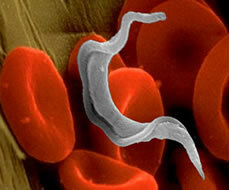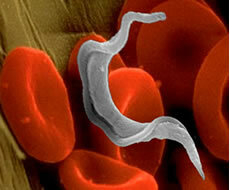In 1909, Carlos Chagas, a researcher at the Osvaldo Cruz Institute, discovered an infectious disease that affected workers in the interior of Minas Gerais. This one, caused by the protozoan Trypanosoma cruzi, is known as Chagas disease, in honor of the person who first described it.

Carlos Chagas
Chagas disease, as it is also called, is mainly transmitted by a insect of the Subfamily Triatominae, popularly known as the barber. This nocturnal animal feeds exclusively on the blood of vertebrate animals. It lives in crevices of wattle and daub houses, beds, mattresses, warehouses, bird nests, tree trunks, among other places, and it prefers places close to its food source.
When sucking the blood of an animal with the disease, this insect starts carrying the protozoan with it. When feeding again, this time from a healthy person, usually in the face region, he can transmit the parasite to him.
This process is due to the habit that he has to defecate after his meal. As, generally, people usually scratch the region where they were bitten, such an act allows the
Transfusion of contaminated blood and mother-to-child transmission during pregnancy are other ways to get the disease. Recently it was discovered that oral infection can occur: these are the cases of those people who acquired the disease by ingesting sugarcane juice or ground açaí containing, accidentally, the insect. It is believed that, in these cases, there was active invasion of the parasite, via the digestive system.
About 20 days after her first – and last – copulation, the female releases approximately 200 eggs, which will hatch in about 25 days. After birth, these small beings will undergo around five molts until they reach the adult stage, forming new colonies.
Do not stop now... There's more after the advertising ;)

Protozoan causing the disease
Fever, malaise, lack of appetite, lymph node pain, eye swelling, and an enlarged liver and spleen are some of the symptoms that may appear initially (acute phase), although there are cases in which the disease presents asymptomatically.
In chronic condition, Chagas disease can destroy the muscles of Organs affected organs (mainly those of the heart and brain), causing an irreversible increase in these. In many cases, only this phase is perceived by the patient, and it can appear decades after the individual has been infected by the parasite.
O diagnosis can be done via the patient's blood test in search of the parasite in the collected material itself (microscopy) or by the presence of antibodies in the serum (through serological tests). O treatment, aiming at eliminating the parasites, is satisfactory only in the initial stage of the disease, when the trypanosome is still in the blood. In the chronic phase, therapy is aimed at controlling symptoms, avoiding further complications.
Barber population control is the best way to to prevent Chagas disease.
THE MINISTRY OF HEALTH WARNS:
Self-medication can have unwanted and unanticipated effects, as the wrong medicine not only does not cure, it can worsen your health.
By Mariana Araguaia
Graduated in Biology
Brazil School Team
Diseases Caused by Protozoa - Illnesses - Brazil School

